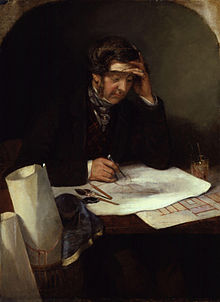T. H. Wyatt
| Thomas Henry Wyatt | |
|---|---|

Thomas Henry Wyatt by George Landseer
|
|
| Born |
9 May 1807 Lough-Glin House, County Roscommon |
| Died | 5 August 1880 (aged 73) London |
| Nationality | British |
| Occupation | Architect |
| Awards | Royal Gold Medal (1873) |
Thomas Henry Wyatt (9 May 1807 – 5 August 1880) was an Anglo-Irish architect. He had a prolific and distinguished career, being elected President of the Royal Institute of British Architects 1870–73 and being awarded its Royal Gold Medal for Architecture in 1873. His reputation during his lifetime was largely as a safe establishment figure, and critical assessment has been less favourable more recently, particularly in comparison with his younger brother, the better known Matthew Digby Wyatt.
Wyatt was born at Lough-Glin House, County Roscommon. His father was Matthew Wyatt (1773–1831) a barrister and police magistrate for Roscommon and Lambeth. Wyatt is presumed to have moved to Lambeth with his father in 1825 and then initially embarked on a career as a merchant sailing to the Mediterranean, particularly Malta.
He married his first cousin Arabella Montagu Wyatt (1807–1875). She was the second daughter of his uncle Arthur who was agent to the Duke of Beaufort. This consolidated his practice in Wales.
He lived at and practised from 77 Great Russell Street. He died there on 5 August 1880 leaving an estate of £30,000. He is buried at St Lawrence's Church, Weston Patrick.
The Wyatts had been a significant architectural dynasty across the eighteenth and nineteenth century.
Wyatt's early training was in the office of Philip Hardwick where he worked until 1832, and was involved in work on Goldsmiths Hall, Euston Station and the warehouses at St Katharine Docks.
He began practice on his own account in 1832 when he was appointed District Surveyor for Hackney ( a post he held until 1861). By 1838 he had acquired substantial patronage from the Duke of Beaufort, the Earl of Denbigh and Sidney Herbert and David Brandon joined him as partner. This partnership lasted until 1851.
...
Wikipedia
